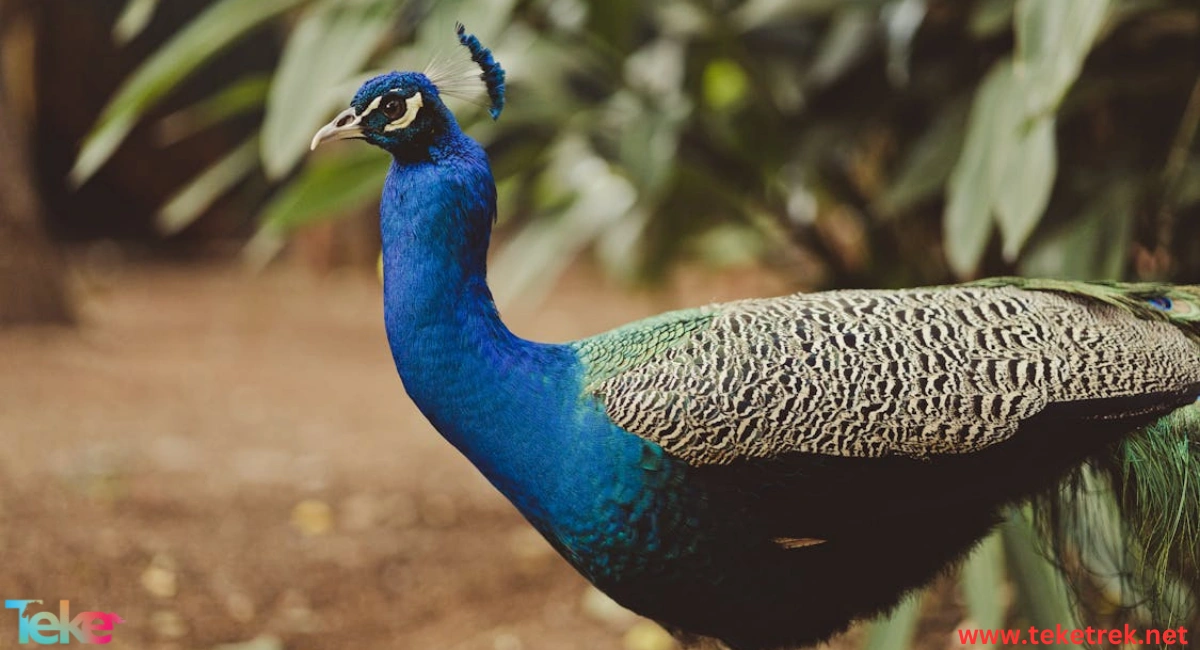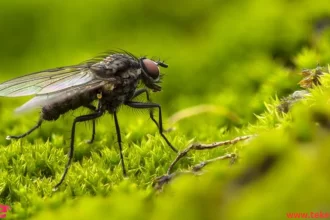The Congo peacock, also known as the African peacock or Mbolo, is a species of peacock, native to the Congo Basin.
It is the national bird of the Democratic Republic of the Congo. Here’s more about it from Teke Trek.

Congo Characteristics: What does a Congo Peacock Look Like?
The Congo peacock belongs to the phylum Chordata, family Trophozoite, genus Afropavo.
The Congo peafowl is characterized by dark brown eyes, a green-bronze body, and a black underside. There is a clear sexual dimorphism in appearance.
The male Congo peafowl is a large bird, reaching a length of 64-70 cm, with dark blue feathers tinged with metallic green and purple.
The male Congo peafowl has a neck with exposed red skin, gray feet, and a black tail with fourteen feathers.
The female Congo peafowl reaches a length of 60-63 cm, characterized by its chestnut brown color with a black belly, a green back, and a short chestnut brown crest.
Both sexes resemble the immature Asian peafowl, and the early taxidermied birds were mistakenly classified as such before being officially recognized as members of a unique species.
Congo peafowl habitat: Where are Congo peafowl found?
The Congo peafowl’s native habitat is the Democratic Republic of the Congo in Africa, specifically found in the eastern regions of the republic.
The Congo peafowl lives in the Okapi Wildlife Reserve, Salonga National Park, Maiko National Park, and Kahuzi-Biéga National Park.
The Congo peafowl is spread in an area located between longitudes 20-28 degrees east and latitudes 2 degrees north to 5 degrees south.
Its northeastern boundary is the Ituri Forest, extending north from the Yekokora River and south between the Lokenie and Sankuru Rivers.
The Congo peafowl lives in lowland rainforests at elevations between 100 and 1200 meters.
These birds are abundant in old secondary forests due to the plentiful food supply.
The Congo peafowl can also be found in areas with low hills, floodplains, and forests with dry soil.
What are the habits of the Congo peacock?
The Congo peafowl typically spends time alone or in small family groups consisting of mating pairs and their offspring.
It is considered territorial, especially during the breeding season.
During the day, the Congo peafowl feeds on the ground, and at night it roosts on tree branches or low brush to communicate with each other.
The Congo peafowl birds fan their tail feathers and emit loud sounds.
Congo food: What do Congo peafowl eat?
The Congo peafowl is a carnivore.
Its diet mainly consists of fruits, insects, and spiders, in addition to mollusks and worms.
Breeding stages of the Congo peafowl:
The Congo peafowl is monogamous and forms pairs.
The breeding season for the Congo peafowl occurs between March and November.
Females lay 2-4 eggs and incubate them for 26-28 days.
Both parents participate in raising their young.
The male Congo peafowl always stays near the nest and guards the female.
The peafowl chicks hatch early and can walk as soon as they are born.
Both parents provide food for their young.
Fledging usually occurs one month after hatching, and the young become sexually mature at two years of age.
The congo peafowl facts
Here is a brief set of information about the Congo peafowl birds:
Its African name: Mbolo.
Length:
The Congo peafowl ranges in length from 25 to 28 inches.
Average adult weight: The Congo peafowl can weigh up to 1.4 kilograms, while the peafowl can weigh up to 1.1 kilograms.
Congo peafowl lifespan
From 15 to 20 years.
Description:
The color of the Congo peafowl is dark blue with green and purple metallic touches.
Its tails are much shorter and lack the “eyes” compared to the Asian species.
The Congo peafowl acquires its adult plumage during the second year of its life.
Habitats:
The Congo peafowl is found in rainforests between elevations of 1197 and 4921 feet.
Locations:
Democratic Republic of the Congo.
Breeding:
Congo peafowl birds lay 2 to 4 eggs in a raised nest box or on platforms placed about five feet off the ground.
The incubation period ranges from approximately 26 to 28 days.
The young can run and forage for food within a few days of hatching.
Diet:
The Congo peafowl enjoys eating fruit, seeds, and small invertebrates.
Conservation status:
Endangered
Predators:
Leopards, tigers, and other large cats.
It is worth mentioning that before the Congo peafowl was recognized as a separate species, the Congolese ate the peafowl and used its feathers for personal adornment.

Frequently asked questions about the Congo peafowl:
What is the color of the Congo peafowl?
The male is dark blue with a green metallic and purple sheen, the female is chestnut brown with a green back and a short chestnut brown crest.
Why is the Congo peafowl named so?
Because its habitat is the Republic of Congo
What is the average lifespan of the Congo peafowl?
The lifespan of the Congo peafowl is from 15 to 20 years.
What are the features of the Congo peafowl?
It is characterized by its bright and beautiful plumage, like other peafowl species. It has a relatively smaller tail compared to the Indian peafowl and the green peafowl.
Where does the Congo peafowl live?
It lives in the Congo region and is the national bird of the Republic of Congo. It is found in lowland rainforests in the Congo River basin.
Is the Congo peafowl endangered?
Yes, the Congo peafowl is an endangered species Efforts must be made to preserve its natural habitat and protect it from threats.
In conclusion
the main threats to the Congo peafowl include habitat loss due to mining, shifting cultivation, and logging.
The birds also suffer from hunting, often being caught in traps intended for small mammals and antelopes.
Refrences





